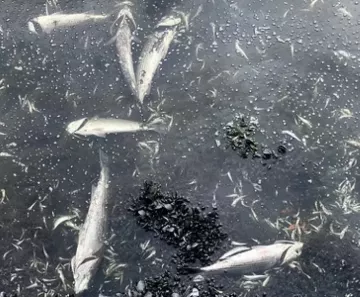Dani Zacky
One year ago last September, our Bay and shorelines were filled with the carcasses of dead fish, and our water was tinted a murky reddish brown. The sheer size and intensity of last year’s algae bloom and fish die-off is not easy to forget. But did you notice the suspicious red color of our water this August? That’s right: on the one-year anniversary of our last algae bloom, like clockwork, reports of red, murky water from around the Bay came streaming into local Bay organizations. The species of algae was identified: Heterosigma akashiwo, the same perpetrator as last year's bloom, meaning we still have plenty of work to do to keep our Bay waters clean and healthy.
Fortunately, the extent of this most recent bloom appears to have been less severe than the last. Unfortunately, once a bloom begins, there is nothing to do but wait it out and assess its damage as it progresses. Science Director for San Francisco Baykeeper Jon Rosenfield said it best: the only way to deal with algae blooms is to prevent them.
The key to algae bloom prevention is well known: we must decrease the amount of nutrients being dumped into the Bay. There are currently 37 wastewater treatment facilities in the region that discharge wastewater into our waterways. The high concentrations of phosphorus and nitrogen in this wastewater act as fertilizer for organisms like harmful algae. When too much of these nutrients are discharged into the Bay, we experience algae blooms that smother fish and other wildlife by using up all of the available oxygen in the water, causing major die-offs like we saw last year. In order to prevent harmful algae blooms in the future, we need to reduce the amount of these nutrients leaving wastewater facilities.
There is an array of options to do this, and several of them offer additional benefits. Some wastewater facilities are opting for a nature-based solution, creating what is called a horizontal levee that mimics a natural wetland. Not only do these levees provide water filtration for nutrients through sediment, but they also can create carbon sequestration from native plants, buffer areas for sea level rise, and areas where biodiversity can thrive. However, the most important option for decreasing nutrients in wastewater discharge is water recycling. When we recycle wastewater, it is treated and purified, allowing for meaningful reuse of otherwise discharged wastewater. This can also help reduce strain on watersheds.
At the SF Bay Chapter, we’re currently focused on asking the Regional Water Quality Control Board to set lower allowable nutrient limits through their permitting requirements for wastewater dischargers. Our ask is that they reduce their allowable limits by 50 percent or more in the next five years. These limits will ensure dischargers will get to work on finding innovative ways to recycle our water and remove excess nutrients, saving innumerable fish and marine creatures and creating a healthier Bay for all of us. If you are interested in working on this campaign, please contact Dani Zacky at dani.zacky@sierraclub.org.
Dani Zacky is an organizer for the SF Bay Chapter.
